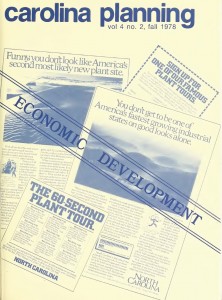 Volume 4.2 Economic Development (1978)
Volume 4.2 Economic Development (1978)
In recent years, North Carolina and the Southeast have experienced an unprecedented level of growth and development. Industries have moved down from the Northeast in search of lower operating costs and a warmer climate. They in turn attract more people to the smaller communities of the Southeast.
Faced with both the positive and negative impacts of growth, states and localities are forced to make important policy decisions. Should industrial attraction be the first priority? How much control should the state or locality exert? To what degree should the private market be allowed to run its course? How can the positive characteristics of small communities and local industries, as well as historic and natural features, be preserved in light of modernization and change?
Editors: Ann Silverman, Norman Axler, Catherine Morris, Ruth Ann Weidner, and Valerie Scopaz
A digital version of this issue is available here.
| ROLES FOR LOCAL PLANNERS IN INDUSTRIAL RECRUITMENT
Redmond, Michael The author suggests changes to current industrial recruitment strategies and roles for the economic development planner. |
| NEW STRATEGIES FOR LOCAL ECONOMIC DEVELOPMENT
Carlisle, Rick The author points out the need for alternative strategies, such as support for existing business and community based enterprises to complement industrial recruitment. These alternative approaches are implemented at the local level and allow the planner a more active role in a community’s economic welfare. |
| IMPACT TAXES: THE OPPORTUNITY IN NORTH CAROLINA
Stroud, Nancy The author presents the impact tax as an alternative to traditional municipal financing, noting the potential effects of new residential construction on existing municipal services. Three forms of the tax are discussed, as well as the legal feasibility and planning implications of impact taxes in North Carolina. |
| NORTH CAROLINA’S HOUSING FINANCE AGENCY: CAN IT BE MORE EFFECTIVE?Hiteshew, KentThe author examines the history and accomplishments of North Carolina’s Housing Finance Agency and outlines a proposal for making the agency more effective in meeting the state’s housing needs. |
| DOWNTOWN REVITALIZATION IN SMALL NORTH CAROLINA COMMUNITIES
Jenny, Patricia The author relays four case studies to document the constraints and resources associated with revitalization efforts. Each approach offers a unique guide to the process of physically and economically rejuvenating downtowns. |
| ENERGY CONSERVATION AND OLDER HOUSING
Howard, J. Myrick Older homes can be made more energy efficient without lessening the actual or potential value of the building. The author discusses various measures of conservation and outlines what planners can do to help. |